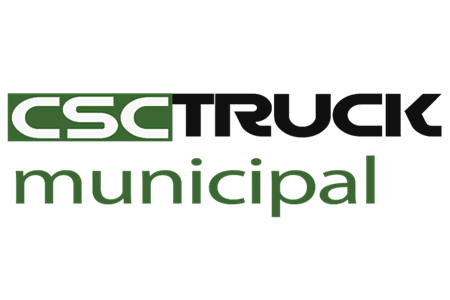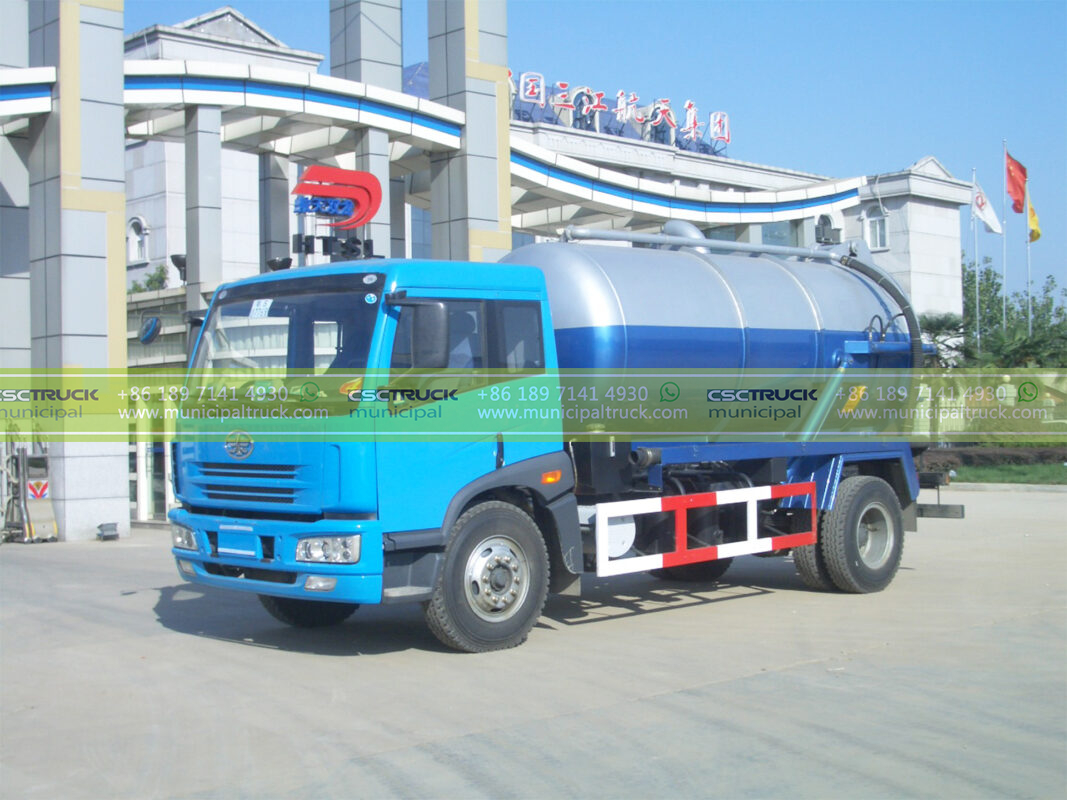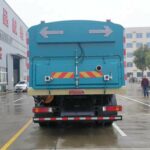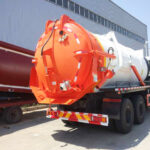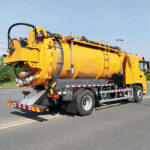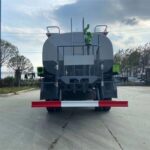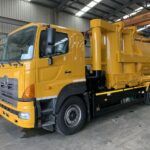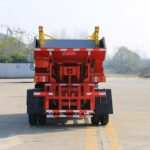Introduction: The Underground Battlefield
Beneath our city streets lies a hidden warzone where grease mountains, root invasions, and sediment avalanches threaten to paralyze essential wastewater flow. When gravity-fed flushing fails and conventional rods retreat, vacuum sewer trucks emerge as the frontline special forces in municipal sanitation. These sophisticated machines combine immense hydraulic force, precision diagnostics, and operator expertise to dissolve obstructions that would cripple urban infrastructure. This exploration reveals the multi-layered strategies deployed by these engineering marvels to conquer the most resilient subterranean blockages.
1. The Vacuum Engine: Generating Unmatched Subterranean Force
Harnessing Physics for Extraction Dominance
The core weapon in this underground conflict is a negative pressure system capable of replicating near-space vacuum conditions:
- Triple-Stage Cyclonic Separation:
Modern trucks employ sequential separation chambers generating differential pressure exceeding 28 inches of mercury. Primary cyclones spin solids at 3,000 RPM, separating debris >2mm before secondary HEPA filters capture particulate down to 0.3 microns. This prevents pump cavitation while handling unpredictable loads—critical when extracting construction debris from sewer cleaner truck operations after storm events. - Regenerative Blower Technology:
Unlike traditional positive displacement pumps, regenerative blowers (e.g., Vactor HX Series) achieve 8,000 CFM airflow with 40% less energy. Their impeller design creates self-cooling vortexes that prevent overheating during extended battles against concrete-like FOG (Fats, Oils, Grease) formations—a common adversary in commercial districts. - Real-Time Viscosity Compensation:
Advanced systems like Federal Signal’s Vactor® Intellisense™ monitor sludge density through ultrasonic sensors, automatically adjusting vacuum levels from 15″ Hg for watery sediment to 26″ Hg for compacted solids. This prevents line collapse in aging clay pipes while ensuring complete extraction in a single pass.
2. Nozzle Warfare: Precision-Targeted Hydro-Kinetic Solutions
Engineered Water Cutting for Obstinate Blockages
When vacuum alone cannot dislodge entrenched obstructions, hydrokinetic nozzles transform water into subterranean artillery:
- Variable-Geometry Jet Heads:
Self-adjusting nozzles like Guerdon’s Sentinel Pro™ deploy tungsten carbide teeth that retract when encountering pipe joints, then extend to scrape walls at 4,500 PSI. Their 360° oscillating jets generate cavitation bubbles that implode grease matrices with micro-shockwaves equivalent to 20,000 PSI localized pressure. - Polymer-Enhanced Hydraulic Fracturing:
For root intrusions, trucks inject viscoelastic fluids (0.5% polyacrylamide solution) that propagate cracks through root masses. The fluid’s shear-thinning properties allow penetration into micro-fissures before expanding to fracture root systems—reducing follow-up visits by 70% compared to pure water jets. - Steam Phase-Transition Systems:
In freezing climates, thermal lances superheat water to 320°F at controlled pressures, instantly melting ice dams through latent heat transfer. The Spartan Tool HydroScorch® system maintains steam stability within 2°F tolerance, preventing pipe damage while restoring flow in -20°F conditions encountered by northern municipal truck fleets.
3. Reconnaissance & Diagnostics: Seeing Through the Murk
Intelligent Mapping for Surgical Interventions
Victory against complex clogs demands unprecedented situational awareness below ground:
- LIDAR-Enhanced Sonar Profiling:
Combined sensor arrays in nozzle heads map pipe interiors while jetting. Acoustic Doppler Current Profilers (ADCP) measure flow turbulence to identify partial blockages, while LIDAR detects wall deformations within 0.5mm accuracy—revealing root hair intrusions invisible to traditional cameras. - AI-Powered Defect Classification:
Machine learning algorithms (Envirosight’s WinCan VX) cross-reference inspection footage with municipal GIS data. The system flags high-risk joints based on historical failure rates and material fatigue models, enabling preemptive cleaning before collapses occur—a game-changer for sewage truck preventive maintenance programs. - Real-Time VOC Spectroscopy:
Fiber-optic sensors in vacuum hoses perform Raman spectral analysis of extracted materials. By detecting molecular signatures of industrial solvents or illegal chemical dumping, crews can immediately alert hazardous materials teams—transforming sewer cleaner truck operators into environmental sentinels.
4. Operator Expertise: The Human-Machine Alliance
Mastering the Art of Subsurface Combat
Technology alone cannot conquer chaotic underground environments; it demands operator virtuosity:
- Haptic Feedback Control Systems:
Advanced joysticks (e.g., Vac-Con CyberSteer™) transmit pipe wall resistance as variable-frequency vibrations. Operators “feel” root density variations and mineral deposits, adjusting jet angles instinctively—reducing collateral damage in fragile vintage pipes by 45%. - Computational Fluid Dynamics (CFD) Simulation Training:
New operators train in VR environments simulating turbulent flow dynamics. The software models how vortex shedding from nozzle heads affects sediment suspension, teaching optimal retrieval speeds for different sludge rheologies—a critical skill when extracting toxic sediments with municipal truck units. - Tribology-Based Lubrication Protocols:
Veteran technicians inject bentonite clay suspensions ahead of grease clogs, reducing pipe wall friction coefficients from 0.6 to 0.15. This allows vacuum forces to peel solidified FOG layers intact rather than fragmenting them—a technique preventing downstream re-clogging in interceptors.
5. Future Frontiers: Autonomy and Advanced Materials
The Next Evolution in Subterranean Warfare
Emerging technologies promise to revolutionize how municipalities combat their most persistent underground adversaries:
- Swarm Robotics for Lateral Line Assaults:
Miniaturized tethered drones (e.g., Sewer Robotics Scout 3.0) now deploy from mainline nozzles, entering 4-inch laterals with micro-jets and vacuum probes. These eliminate the need for property access during residential backups—slashing neighborhood disruption times from hours to minutes for sewer cleaner truck crews. - Self-Propelled Cryogenic Nozzles:
Prototypes using liquid nitrogen (-320°F) flash-freeze grease bergs into brittle masses that shatter under low-pressure jets. The DeepFreeze DF-7 system contains cryogen within magnetic fields, preventing pipe embrittlement while reducing water usage by 85%—a sustainability breakthrough for drought-stricken regions. - Bio-Mechanical Hybrid Systems:
Genetically engineered Pseudomonas strains encapsulated in polymer beads are injected ahead of clogs. Activated by H2S, they produce biosurfactants that dissolve FOG bonds while enzymes digest cellulose roots—turning the sewage truck into a mobile bioremediation platform.
As climate change intensifies storm surges and urban densification strains century-old infrastructure, the municipal truck evolves beyond brute-force extraction into a data-integrated guardian of public health. Tomorrow’s vacuum trucks will predict blockages before they form using AI analysis of wastewater metabolite signatures, deploy self-replicating repair resins at fracture sites, and convert extracted waste into pavement binder via onboard pyrolysis reactors. For now, these technological marvels stand as our most potent defense against the chaos lurking beneath manhole covers—ensuring cities flow smoothly, one devastating vacuum surge at a time.
